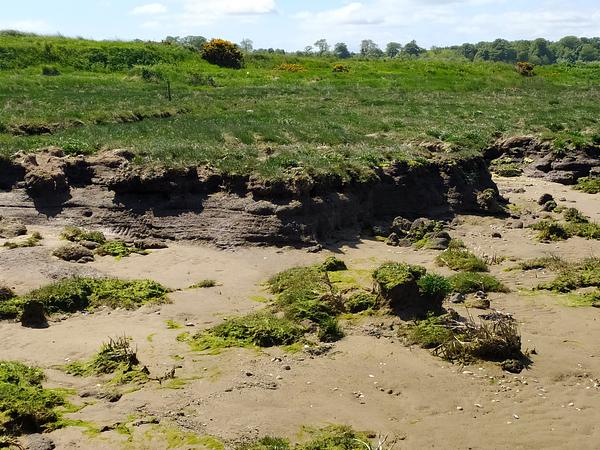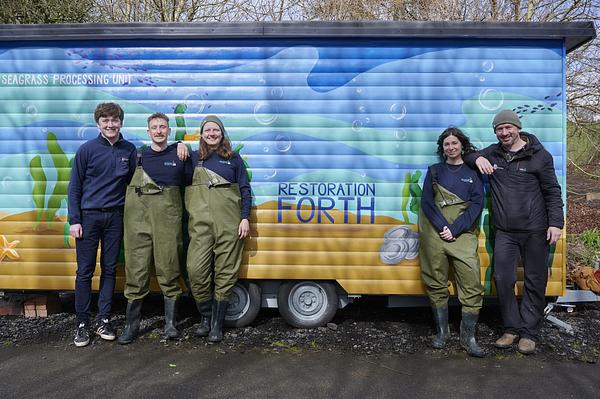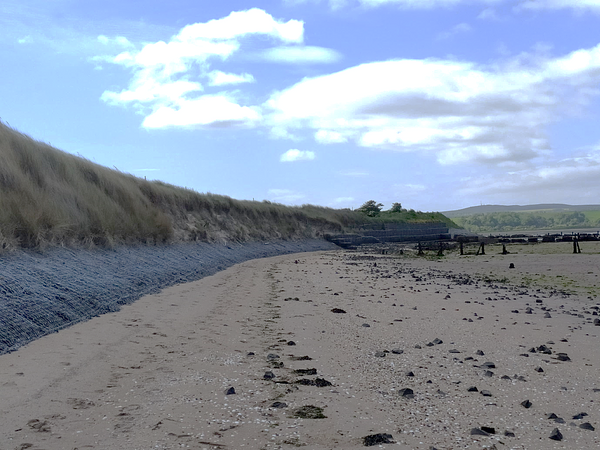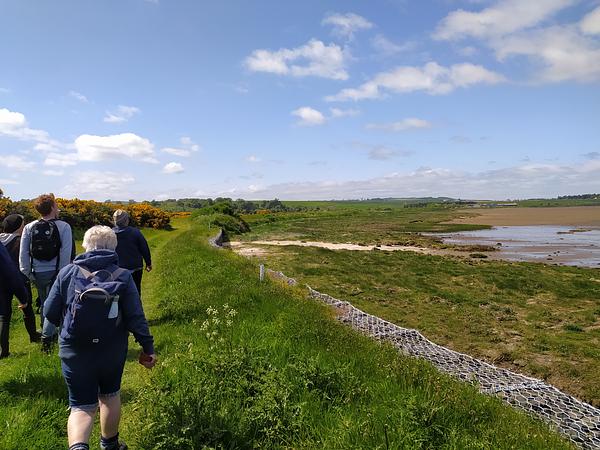
Coming Together to Conserve our Coastlines
By Emma Marriott, Conservation Assistant
When conjuring images of Scotland’s coastline, we usually recall rockpools, beaches and tall, rugged cliffs—yet there is so much more to our coasts. From mudflats and saltmarshes to seagrass meadows and oyster reefs, intertidal and estuarine areas (where rivers meet the sea) encompass a plethora of important habitats. They are often overlooked, hidden away for much of the day beneath brackish water and waves, yet they are vital to the health and structure of those coastal features we are most familiar with.
Oysters, seagrass and saltmarsh plant species improve water quality by removing excess nutrients, chemical contaminants and biotoxins from the water and storing them in their tissues. Seagrass and saltmarsh plants absorb them through their leaves and roots, whereas oysters catch and consume particles (including algae and plankton, which contain nitrogen and phosphorus that will degrade aquatic environments if they accumulate) by filter-feeding. Incredibly, one oyster might pump as much as 45 gallons of water through its gills per day—that’s almost 205 litres by something that may only be 5 – 11 cm long!
RJ_Lilley.jpg)
They also stabilise sediments. Seagrass roots, saltmarshes and dense oyster beds trap and accumulate sand, silt, and dirt. They also increase underwater friction, reducing water flow and wave energy. By slowing the flow of water, they help prevent the erosion and suspension of sediments. This in turn aids carbon storage, as settled sediments capture and hold onto organic matter—a source of carbon—and prevent its release into the atmosphere. In fact, a recent study found that seabed sediments (including saltmarshes) stored as much as 98% of the total organic carbon in the English North Sea.
By capturing sediments and keeping them in place, saltmarshes especially will raise the height of the land as substrate accumulates, keeping pace with rising sea levels.
RJ_Lilley.jpg)
And, of course, they are all fantastic habitats. Dense seagrass meadows and oyster beds—with all their cracks and crevices—act as protective nurseries for commercially important fish species such as Atlantic Herring (Clupea harengus) and Atlantic Cod (Gadus morhua) and are used by many other species at various stages of their life cycles. Meanwhile, saltmarshes support invertebrates in high densities, which in turn feed waterfowl and wading birds.
Unfortunately, these habitats are vanishing or under threat. Since the mid-19th century, native oyster reefs have suffered a decline of 95% as a result of dredging, over-harvesting and pollution to name only a few factors. Seagrass meadows, too, are struggling in areas with low water quality because—like terrestrial plants—they require sunlight to photosynthesise and may be smothered by excess sediments and murky water. As for saltmarshes, erosion, historic pollution and the conversion of coastal land for development are resulting in their deterioration.

Fortunately, these issues have not gone unnoticed. Growing concern for coastal and marine habitats has rallied communities, the research community, and organisations to come together in the battle against their decline. From this, groups like Restoration Forth and Green Shores have grown.
Based in the Firth of Forth, Restoration Forth is helping to re-establish seagrass meadows and native oyster reefs around the coastline. A three-year conservation project led by WWF-UK and partnered by local communities and organisations, the team and its network of volunteers are driven to restore 1 hectare of seagrass meadow and 10, 000 native oysters by the end of this year. Through the project, they also strive to motivate the Scottish government to implement stronger policies for marine protection.
Our very own Seagrass Officer Marie Seraphim is part of this fantastic project and is often out and about at the various seagrass restoration sites around the Firth of Forth. When she isn’t snorkelling in the shallows or wallowing in coastal mud picking and planting seagrass seeds, Marie finds the time to write about the exciting progress that is being made through the project. You can read more about Restoration Forth from Marie herself in her inspiring blogs.

Elsewhere on the East Coast, the Green Shores partnership—led by Dr Clare Maynard of St Andrews University—has been endeavouring to enhance degraded areas of shoreline by replanting and improving fringe saltmarsh in the Eden and Tay estuaries and the Dornoch Firth. With the invaluable help of coastal landowners and hundreds of volunteers of all ages and backgrounds, the partnership has harvested and grown saltmarsh plants, including saltmarsh grass (Puccinellia maritima), sea club rush (Bolboschoenus maritimus) and common glasswort (Salicornia europaea), planting them into bare areas and gaps in the marsh, or in key areas where the shoreline is especially vulnerable.
Why? Because these habitats are not only valuable to wildlife but to people, too. Acting as buffers against the destructive nature of waves, they stabilise the shoreline and raise land levels through the accumulation of sediment.

Rising sea levels and coastal erosion are becoming an increasing concern, globally and across UK coastal areas. Various methods have been tested to combat the issues, but most are costly and ineffective, or they can be detrimental to surrounding habitats and wildlife. By restoring seagrass, oyster reef and saltmarsh habitats, we would not only benefit biodiversity—we could also help protect human coastal communities against land loss, floods and nutrient pollution.
It’s clear how important these endeavours are, but it can be difficult for localised community groups to get their voices heard. This is where Coastal Communities Network (CCN) comes in. Founded in 2022, CCN functions as a place for local groups and organisations to discuss working together to tackle challenges and to share ideas and opportunities in marine management and restoration. From Berwick-Upon-Tweed to New Haven, and Arran to the Outer Hebrides, the CNN unites groups all over Scotland (including one of Restoration Forth’s founding members, Edinburgh Shoreline) and reaches out to others with the vision of empowering community-led restoration of the marine environment.

Recently, CCN Restoration Group organised a site visit to the Tay and Eden estuaries to see Green Shores’ saltmarsh restoration work in person. I was lucky enough to tag along, joining a few fascinated volunteers as well as Marie and some of her colleagues at Restoration Forth. We learned a lot from it; ideas and advice were shared, which is what CCN is all about.
Ultimately, these projects hope to impassion local people about these vital habitats and inspire them to nurture and protect them for years to come—because through their mere existence, these habitats will help protect us, too.
The partners
Restoration Forth, kick-started by Edinburgh Shoreline, Heriot-Watt University and Project Seagrass, is led by WWF-UK and unites partner organisations such as the Royal Botanic Garden Edinburgh, the Marine Conservation Society and community hubs centred around the Ecology Centre in Fife, Fife Coast and Countryside Trust, Heart of Newhaven Community, and ourselves at the Scottish Seabird Centre. The programme is made possible through funding provided by Aviva, the ScottishPower Foundation, and the Moondance Foundation. It is also supported by the Scottish Government’s Nature Restoration Fund, which is facilitated by the Scottish Marine Environmental Enhancement Fund (SMEEF) and managed by NatureScot.
Many thanks to NatureScot for supporting Dr Clare Maynard at St Andrews University with the project ‘Green Shores: Restoring Biodiversity and Resilience to Fringe Saltmarshes’ through the Nature Restoration Fund, with additional support from St Andrews Links Trust, Royal Dornoch Golf Club, Ministry of Defence and Fife Council.
The CCN is funded by Fauna and Flora (previously Fauna and Flora International) and its members include Berwickshire Marine Reserve, Charlestown, Limekilns and Pattiesmuir Nature Conservation Group, Clean Coast Outer Hebrides, Community Association of Lochs and Sounds, Community of Arran Seabed Trust, East Haven Together, Edinburgh Shoreline, Eigg Environmental Action Group, Fair Isle Marine Research Organisation, Fairlie Coastal Trust, Friends of Loch Hourn, Friends of the Sound of Jura, Largo Communities Together, Orkney Skate Trust, Little Loch Broom Marine Life, South Skye Seas Initiative, the Ecology Centre, Craignish Restoration of Marine and Coastal Habitat, Knoydart Climate Action Group, AFFtheClyde and Fisherrow Harbour & Seafront Association.
To learn more about Restoration Forth and what they do, visit our information page.
To keep up to date with what’s happening at the Scottish Seabird Centre throughout the year, check out our regular blogs or follow us on Facebook or Twitter.

My role as Conservation Assistant has been funded by The National Lottery Heritage Fund via the New to Nature programme - an exciting initiative that is helping to support people from diverse backgrounds into environmental roles. To find out more, visit: www.groundwork.org.uk/new-to-nature-apply
